 Image search results - "post" Image search results - "post" |

Old mail box.
|
|
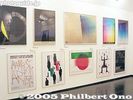
Poster exhibition 日本のポスター展In the huge, cavernous basement of the Palazzo Ducale, over 600 artistic Japanese posters were on display.
地下の凄い大きいホールになんと600枚のポスターが展示。
|
|

Poster exhibition
|
|
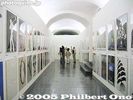
Poster exhibition
|
|

Poster exhibitionA few expo posters. Even those poster designs which were not selected to be the official poster design were included in this exhibition.
|
|
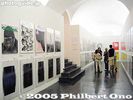
Poster exhibition
|
|

Poster exhibition
|
|

Poster exhibition catalog: Manifesti D'Artista 1955-2005 ポスター展の図録All 600 posters featured in the exhibition is reprinted in this thick catalog called "Manifesti D'Artista 1955-2005," published by Ideart. Language is Italian. Order from PhotoGuide Japan's iStore.
|
|
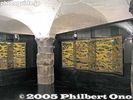
Folding screen 屏風も
|
|
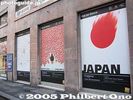
Posters at Genova Fnac Bookstore 市内のFnac本屋でPRThe Fnac Bookstore was generous enough to provide space on their outdoor walls to publicize the exhibition with replicas of the posters and photos.
フランスに本社がある大手本屋さんのFnacのジェノバ店で今回の展覧会をPRするために展覧会関係の巨大ポスターを店の壁に張ってくれました。
|
|

Posters at Genova Fnac Bookstore
|
|

Posters at Genova Fnac BookstoreShot of bombed Nagasaki above one entrance.
山端庸介の長崎原爆写真も入口の上に。
|
|
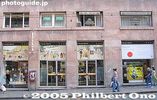
Ukiyoe at Genova Fnac BookstoreUkiyoe decorates the bookstore facing the main street.
|
|

Bamba-juku (Banba-juku) does not have any train stations within walking distance. The closest is Maibara and Samegai Stations. Buses and taxi available. From Samegai, go on Route 21 until you reach this intersection (3 km from Bamba) where you turn left.
|
|

You will soon see this Hokuriku Highway overpass. Go under it.
|
|

Then you'll see a fork in the road. Take the smaller right road which is the former Nakasendo Road.
|
|

The island in the middle has a Bamba-juku monument.
|
|

Bamba-juku monument marking the location of the Kure Ichirizuka milestone. 久禮の一里塚 MAP
|
|

Old Nakasendo Road to Bamba-juku, the sixty-second station or post town (shukuba) of the sixty-nine stations on the Nakasendo Road.
|
|

Bamba-juku is the third Nakasendo station in Shiga, following Samegai-juku which is also in Maibara.
|
|

Finally a small sign on the left declaring "Nakasendo Bamba-no-juku."
|
|

Marker for site of a Toiya-ba which was a travel logistics office where you can get pack horses, forward your baggage, and find a place to stay in Bamba. 問屋場
|
|

Bamba today is a quiet, rural settlement. It is divided into east Bamba and west Bamba.
|
|

Another welcome sign in Bamba-juku.
|
|

Welcome sign in Nakasendo Bamba-juku. (The orange object is a mailbox.)
|
|

Site of another Toiya-ba.
|
|

Intersection with a Bamba-juku stone monument. A good place to rest and eat your box lunch.
|
|

Bamba-juku stone monument.
|
|

Next to the Bamba-juku stone monument is an old map of Bamba-juku.
|
|

Stone marker with a finger pointing the way to Maibara Port where you can board a boat to go to Otsu via Lake Biwa. This is at the same intersection across from the Bamba-juku stone monument.
|
|

Site of the Waki-Honjin on the right. Now a modern house. The Waki Honjin was the town's second-best lodge. 脇本陣跡
|
|

Close-up of stone marker for the Waki-Honjin. There are no original buildings left in Bamba-juku related to the post town, except for Rengeji temple.
|
|

Site of the Honjin, the town's most exclusive inn for daimyo lords and other VIPs. This is not the original building. Just a private house. Near the Waki Honjin. 本陣跡
|
|

Going further down the road in Bamba.
|
|

Place where Emperor Meiji took a break. It was the site of another Toiya-ba.
|
|

Marker indicating that Emperor Meiji took a break here once.
|
|

On the left of the road is the path to Rengeji temple.
|
|

Path to Rengeji temple.
|
|

Smack dab in front of Rengeji temple is this monstrosity that is the Meishin Expressway.
|
|

Right after passing under the Meishin Expressway, you see Rengeji's Sanmon Gate. 蓮華寺 山門
|
|

Rengeji is famous as the place where Hojo Nakatoki 北条仲時 and over 430 of his men committed suicide after being defeated by Ashikaga Takauji's forces during the fall of the Kamakura shogunate in 1333. This is a monument for this tragic event.
|
|

On the left of the Sanmon Gate is the "River of Blood." When Hojo Nakatoki and 430 of his men slit themselves on May 9, 1333, the blood became a river flowing here. It was during the Genko War when the Emperor Go-Daigo fought the Kamakura shogun
|
|

"River of Blood" sign. In charge of national security, Hojo Nakatoki was the last Rokuhara Tandai Kitakata chief from the Hojo clan in the Kamakura shogunate. When tourists see this sign, they become scared to enter the temple.
|
|

Rest assured, it's very peaceful in the temple. Rengeji's Sanmon Gate (right) and bell tower on left.
|
|

Wooden insignia on Sanmon Gate with the Imperial crest on the left. The temple was originally founded by Prince Shotoku Taishi about 1,300 years ago. He named it Horyuji 法隆寺. After being struck by lightning, it was rebuilt in 1284.
|
|

Rengeji temple belongs to the Jodo-shu Buddhist sect. The founding priest was Saint Ikko. With support from the lord of Kamaha Castle near Bamba, he was able to rebuild the temple and renamed it Rengeji. 一向上人
|
|

Rengeji Hondo Hall, Banba-juku, Maibara, Shiga. Quite a few emperors favored this temple. The 95th Emperor Hanazono (1297-1348) gave the temple an Imperial sanction to receive Imperial prayers. Hence, the temple's Imperial crest. 蓮華寺
|
|

Until 1943, the temple was a dojo for the Jishu Ikko sect. It then converted to Jodo-shu. Admission is charged, I think 300 yen. There's a unmanned collection box near the entrance.
|
|

Red plum blossoms in front of Rengeji Hondo Hall, in early April.
|
|

Inside Rengeji Hondo Hall, left altar.
|
|

Inside Rengeji Hondo Hall, main altar at the center. There are two figures: Amida Nyorai and Shaka Nyorai. Jodo-shu Buddhist sect. 蓮華寺 本堂
|
|

Inside Rengeji Hondo Hall, main altar at the center. 蓮華寺 本堂
|
|

Inside Rengeji Hondo Hall, right altar.
|
|

Rengeji Hondo Hall's framed nameplate. The temple's name was written by Emperor Go-Mizunoo (1596–1680).
|
|

This is the area where Hojo Nakatoki and his men committed seppuku.
|
|
|

Bell tower. Cast during the time of Saint Ikko, the bell is an Important Cultural Property.
|
|

Inside is a Jizo-son statue worshipped for transportation safety.
|
|
|

Memorial for victims of the Pacific War.
|
|

Monument for a poem by Saito Mokichi (1882-1953). 斉藤茂吉の歌碑 「松風の音を聞くときは 古への 聖の如く 我は寂しむ」
|
|

Grave of the lord of Kamaha Castle who helped to rebuild the Rengeji temple.
|
|

Way to the graves of Hojo Nakatoki and his men who committed suicide.
|
|

A few steps up a slope.
|
|

Memorial for Hojo Nakatoki and his men. They had lost to Ashikaga Takauji in the battle at Kyoto and were trying to escape to Kamakura, but was caught by Takauji's forces at Bamba.
|
|

Over 430 gravestones. Hojo Nakatoki and his men were besieged in Bamba by Southern Imperial Court forces. They fought back, but lost and slit their bellies in front of Rengeji's Hondo main hall.
|
|

The temple's third priest wrote the names and age (youngest was 14) of the known fallen warriors in a scroll. He also made these gravestones for them. Visuallly, it's very impressive edifice.
|
|

Graves of Hojo Nakatoki and his men from the Rokuhara Tandai. 北条仲時一行の墓
|
|

The gravestones have five levels. In fall, the surrounding maple leaves turn blood red.
|
|

There are more steps which lead to graves of temple priests and Saint Ikko's mausoleum.
|
|

Graves of previous temple priests.
|
|

Mausoleum of Saint Ikko Shunsho.
|
|

Small mausoleum for Saint Ikko. 一向上人の御廟
|
|

Side of the Hondo
|
|

Behind the Hondo hall is a small hill with the Bamba Chutaro Jizo-son statue.
|
|
|

Bamba Chutaro Jizo-son statue, based on a character in the novel "Mabuta-no-Haha" 瞼の母 by Hasegawa Shin (1884-1963) 長谷川伸. 番場忠太郎
|
|

View behind the Hondo.
|
|

Also behind the Hondo is this Ikko-sugi tree, 700 years old. Named after the temple's founding priest Saint Ikko, it was planted where Ikko was cremated. Over 30 meters high and 5 meters wide. 一向杉
|
|

Temple garden. Best during spring when the flowers bloom.
|
|

View from Hondo hall.
|
|

From Rengeji temple, a short distance away on the Nakasendo Road is this path to Naotaka Shrine.
|
|

Naotaka Shrine, dedicated to Lord Ii Naotaka, the third lord of Hikone Castle. 直孝神社
|
|

Naotaka Shrine torii
|
|

There's no explanation about the shrine.
|
|

Naotaka Shrine
|
|

The shrine has no human staff, but a security camera operates.
|
|

Naotaka Shrine Honden Hall
|
|
|
|
|

Turn left to hike to Kamaha Castle ruins. 鎌刃城
|
|

Map of Kamaha Castle. 鎌刃城
|
|

Path to Kamaha Castle, a mountaintop castle in the distance. Only stone walls remain. 鎌刃城
|
|

Kitano Shrine
|
|

Bamba-juku monument
|
|

A stone found in a river bank. Since it has a hole, it is thought to be a foundation stone for a building's pillar.
|
|
|
|

Echigawa-juku was the sixty-sixth station or post town (shukuba) of the sixty-nine stations on the Nakasendo Road. It is the sixth Nakasendo station in Shiga (following Takamiya-juku in Hikone), and one of ten Nakasendo stations in Shiga.In front of Echigawa Station, a sign point the way to Echigawa-juku (go right).
|
|

Entrance to Echigawa-juku at the northern end. Echigawa-juku was the sixty-sixth station or post town (shukuba) of the sixty-nine stations on the Nakasendo Road. Map
|
|

This is a high-class ryotei restaurant called Omi Shonin-tei (近江商人亭). Built in the 1920s, it used to be an Omi Merchant's second home who sold hemp cloth.This is also one location where the film Idai Naru, Shurararabon (偉大なる、しゅららぼん The Great Shu Ra Ra Boom) was filmed. The Natsume family's dojo scene.
|
|

Nakasendo in Echigawa-juku
|
|

Large intersection has an Echigawa-juku monument.
|
|

The street corner has a pocket park for an Echigawa-juku monument showing an ukiyoe print of the town. A stone marker also points the way to Takamiya-juku.
|
|

The ukiyoe print by Hiroshige shows a bridge across Echigawa River. It was toll-free (Muchin-bashi).
|
|

Meiji Period-style mail box. It's a real mail box so you can deposit your mail here.
|
|

Pocket park in Echigawa-juku.
|
|

Heading south on the Nakasendo in Echigawa-juku.
|
|

Traditional-style building
|
|

Marker indicating that St. Shinran, founder of the Jodo Shinshu Buddhist Sect, once stayed at this temple.
|
|

Way to Homanji temple where St. Shinran once stayed.
|
|

Gate to Homanji temple.
|
|

Homanji temple Hondo hall in Echigawa-juku, Shiga. 宝満寺
|
|

Statue of St. Shinran (1173-1263) in front of the plum tree which he planted. The temple also has a scroll written by Shinran.
|
|

While traveling, St. Shinran was unable to cross the Echigawa River since there was a flood. So he stayed at this temple temporarily. During that time, he planted a plum tree which bloom red plum blossoms.
|
|

St. Shinran statue and plum tree.
|
|

The plum tree blooms in March.
|
|
|
|

Homanji Hondo
|
|

Inside Homanji Hondo main hall in Echigawa-juku, Shiga Prefecture
|
|

View from Hondo hall.
|
|

Some modern buildings along the Nakasendo in Echigawa-juku
|
|

Looks like a former bank building.
|
|

Hachiman Jinja Shrine in Echigawa-juku, Shiga
|
|

Way to Hachiman Shrine.
|
|

Hachiman Jinja Shrine, Echigawa-juku
|
|

The shrine has ties to Prince Shotoku Taishi who hid here from an enemy during a war. In appreciation, he donated rice paddies to the shrine.
|
|

Hachiman Jinja Shrine Honden main hall is a Shiga Prefecture Cultural Property.
|
|

Shops along the Nakasendo
|
|

Manhole in Echigawa-juku, Shiga, with a temari (thread ball) design.
|
|

Another famous building remaining in Echigawa-juku. This is the Takeheiro restaurant where Emperor Meiji once stayed.
|
|

Entrance to Takeheiro. It's not open to the public unless you want to dine there. 竹平楼
|
|

Stone monument at Takeheiro indicating that Emperor Meiji was here.
|
|

Takeheiro on the left, along the Nakasendo Road in Echigawa-juku, Shiga.
|
|

Toward the south end of Echigawa-juku. Bridge has a temari decoration.
|
|

Temari decoration on bridge.
|
|

South end gate of Echigawa-juku.
|
|
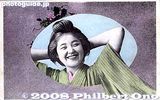
Out of all the geisha that have appeared on postcards, this ever-smiling geisha was unsurpassed in popularity. Her smiling visage appeared in 40 to 50 different poses in photographs and postcards made in Yokohama from the 1890s.
|
|

Her affable and infectious smile made her stand out during a time when most people posing for a photograph did not smile.
|
|
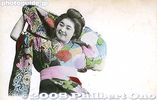
Her name has been a mystery, but I have come across hard evidence that she was a geisha named "Tokimatsu." But I will forever call her the "Laughing Geisha."
|
|
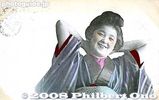
A saucy little Geisha. The pose is good.
|
|

Laughing Geisha with low neck. She's almost semi-nude. It is probably her sexiest pose of all. A great summertime card and one of my favorites. Hand-colored and postmarked Feb. 25, 1908 in Yokohama. The actual card is more yellowed.
|
|

Laughing Geisha with cowboy hat & cigar. This must be the most humorous pose she created. Those tourists must've gotten a big kick when they saw this card. A geisha from the wild, wild West. Even today, it elicits an affectionate laugh. One of my
|
|
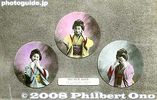
See, hear, nor speak no evil.
|
|
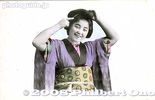
Combing her hair.
|
|
|
|

Laughing Geisha with fan. There are two Yokohama postmarks on this card. One in Japanese (over the stamp) and one in English. The actual card is more yellowed and almost brown, but I bleached it with Photoshop.There are two Yokohama postmarks on this card. One in Japanese (over the stamp) and one in English. Japanese postmarks have the date in the Year-month-day format. And English postmarks have it in the Day-month-Western year format. As you may know, Japan bases its years on the Emperor's reign. In the Japanese postmark, you can see "36" for the year. That's not 1936, but Meiji 36 that corresponds to 1903. Besides the Meiji Period (1868-1912), there's the Taisho Period (1912-1926) and the Showa Period (1926-1989). Since the Japanese postmark only indicates the last two digits of the year, it can be a pain to figure out which period the year belongs to. In most cases, we can figure it out with the stamp or type of postcard back.
|
|

Laughing Geisha on terrace. It looks like she's on the veranda of a restaurant along a river. If she's a Kyoto geisha, it would be the Kamo River. But these cards were made in Yokohama. I wonder if she was from Yokohama.
|
|

Laughing Geisha looking out. The card is postmarked 1903 from Yokohama. The actual card is more yellowed and almost brown, but I bleached it with Photoshop.
|
|

Laughing Geisha with baby. She's nicely posed, and you can even see the baby's face. But the color of her kimono is somewhat drab. A mother (or married woman) does not and need not wear a colorful kimono.
|
|

Laughing Geisha with umbrella. The sender probably wrote about his incredible adventures in Japan. Postmarked 1904 from Yokohama addressed to Hamburg, Germany. The actual card is more yellowed and almost brown, but I bleached it with Photoshop.
|
|

Laughing Geisha with umbrella. As you may have noticed, the umbrella (and fan) was a commonly used prop in tourist photos. Postmarked 1903 from Yokohama. The actual card is more yellowed and almost brown, but I bleached it with Photoshop.
|
|

Laughing Geisha in the rain. There's a horse in the background. Maybe she's watching a parade. The ground looks wet.
|
|

Laughing Geisha with Basket. It looks like she's dressed for picking tea leaves. This card, which has an undivided back, dates before 1907. The actual card is more yellowed.
|
|

Another shot of her picking tea leaves.
|
|
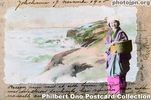
Laughing Geisha on Shore. It's kind of strange to see her at the beach but dressed to pick tea leaves. The message on this postcard was written in French, dated 1905.
|
|

Drawing water from a well.
|
|
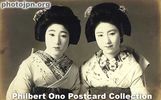
Pair of Geisha, autographed. One of my most treasured cards. This card was signed (on the chest area) by these two geisha with a fountain pen. Several other geisha also signed the back of the card. (See the next image.)
|
|
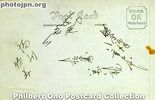
Pair of Geisha, autographed (back). This is the back of the preceding card. It looks like four geisha signed it.
|
|
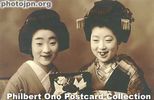
Geisha and maikoNot a good photo, but their names are written in hiragana on the back. They read "Suimatsu" on the left and "Shigezuru" on the right who is a maiko, not geisha. She has more ornaments in her hair than the geisha. Also notice their blackened teeth. If they are in Kyoto, a geisha is called "geiko." In Tokyo, a maiko (apprentice geisha) is called "hangyoku." This is a postcard-size photo and not a postcard.
|
|
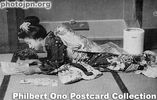
Maiko in Her RoomA private moment. This maiko is lying down in her kimono reading a comic book after getting tired of playing cards. Her mama-san probably would not be pleased to see her wrinkle the kimono like that. Not sure if this was staged or a candid shot. It's hard for anyone to lie down like that in a kimono.
|
|

Oiran courtesan. Also see my photos of an oiran show here. My oiran video at YouTube here.The highest-ranking geisha is called an oiran or tayu. She is escorted by two little attendant girls called kamuro. Notice her high clogs. It takes some skill to walk in those and she usually requires someone's shoulder to hold onto while walking. Sometimes at festivals or special events, you can see the Oiran Dochu procession where she walks in a parade together with geisha attendants.
|
|
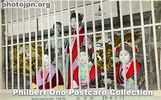
Shin-Yoshiwara prostitutes. They are sitting behind the "cage" which fronted the street for all to see (and choose) within the licensed quarters. Shin-Yoshiwara was a famous red-light district of Tokyo. Note that they are not geisha.Geisha were not prostitutes. This photo was taken during 1907-1911. The woman in the far back was the brothel's matron who supervised this live display and everything else. In 1912 when Emperor Meiji died, this live display of women was later replaced by framed photographs of each woman hung near the brothel's entrance. In 1958, prostitution was outlawed in Japan, and Yoshiwara was history.
|
|
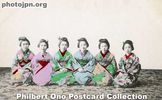
Brothel maids or prostitutes. Maids were employed to guide patrons to their rooms and serve sake and food. Or they could be low-class (cheap) prostitutes. Hand-colored, undivided back.
|
|

Geisha Pair Outside Geisha House. These two geisha know how to pose for the camera. It looks like Kyoto. You can tell that they are geisha because of the shorter kimono sleeve, subdued kimono design (mostly black), and their clogs (for rainy weather).
|
|

Patriotic Maiko. Card designed to encourage soldiers on the front line. Notice that her sleeves are so long that you can see her right sleeve touch the ground. That's the kimono of a maiko. This is a modern postcard reproduction.
|
|

Two Patriotic Maiko. To cheer up the soldiers on the front line, pretty and smiling maiko (apprentice geisha) often appeared on postcards for military mail. This card was postmarked Aug. 1940 from Shizuoka city. It was not addressed to a soldier though.Both women are maiko and not full-fledged geisha yet. The sleeves of a maiko's kimono reaches toward the ground as you can see here. (The sleeves of a geisha is shorter.) The kimono design is also more colorful and gaudy. Maiko also wear clogs called pokkuri. They are wedged at the front, so if you are not careful, you can trip forward. Geisha do not wear pokkuri.
|
|

Smiling Maiko Standing. Great smile. This is the same woman in the card where two maiko are holding the Japanese flag.
|
|

Smiling Maiko Sitting. Real-photo postcard to cheer up soldiers. This card was sent as military mail from Kyoto on New Year's Day 1939. The kanji characters on the fan says "Banzai," the traditional Japanese cheer for victory and happy occasReal-photo postcard to cheer up soldiers. This card was sent as military mail from Kyoto on New Year's Day 1939. The kanji characters on the fan says "Banzai," the traditional Japanese cheer for victory and happy occasions. It also means "long life," something that soldiers would like.
|
|

Laughing Maiko. Another card to cheer up the men at the front line.
|
|

Maiko hair ornaments. Maiko have more ornaments in their hair than geisha do. The hair ornaments differ depending on the current season. They usually have a flower motif, and if you look closely and see what flower it is, you can tell what season it is.
|
|

The maiko uses her real hair, not a wig. When her hair is down, it reaches her chest.
|
|

Smiling Maiko sitting in gardenNotice her left sleeve reaching the ground. A sign of a maiko's kimono, not a geisha's. Also, the high clogs that she wears are called pokkuri. Maiko wear them, but geisha do not.
|
|

Maiko on Gojobashi Bridge. Postcard-size real photo taken in Kyoto. She has been poorly posed. Her posture is bad, her kimono is ruffled, the sleeves look bad, and her feet are pointing in the wrong direction. Maiko usually know how to pose themselves.Postcard-size real photo taken in Kyoto. She has been poorly posed. Her posture is bad, her kimono is ruffled, the sleeves look bad, and her feet are pointing in the wrong direction. Maiko usually know how to pose themselves for a photograph. But not this one. Perhaps she's an amateur.
|
|

Maiko with umbrella. The quickest way to tell if she is a geisha or maiko is by looking at her back. The tell-tale sign of a maiko is her long obi sash hanging down behind. Whereas the geisha's sash has a short knot instead.
|
|

Girl with Umbrella. Hand-colored postcard dating before 1918. The kimono looks like casual wear, and the design pattern was typical during the turn of the 20th century. She's still in her teens it seems. One of the first vintage postcards I bought. Y2
|
|

Girl in Storm. Wires were used inside the kimono to make it look wind-blown like in a rainstorm. Even her clogs are for rain. Early photographers commonly imitated the poses and scenes depicted in ukiyoe woodcut prints and Nihonga paintings.Although the photographer and model were serious in making this picture, it makes you laugh.
|
|

Cheek-to-Cheek. One of my favorite postcards. I wonder if they were sisters. Real-photo postcard with no divided back. The actual card is more yellowed, but I bleached it with Photoshop.
|
|

Mona Lisa Smile. She's cute, ideal for a passport photo. But her hairstyle is more striking than anything. What do you call it? A Westernized Japanese hairstyle?
|
|

After a bath. That's what it looks like. She was another very photogenic woman.
|
|

Smiling for the camera. It's always nice to see a smiling woman on a vintage postard. This is not an ideal smile though. Kind of sheepish and unnatural. Sort of half-hearted and "halfway" like her fan which is only half open.
|
|
|
|

Swimsuit Beauties. These are typical swimsuits worn during the late 19th century. Horizontal stripes were in vogue. They are not posed very well, but there's something charming about them. This postcard is postmarked Aug. 1912. A nice summertime greet
|
|

Swimsuit pin-up. Another picture that makes you laugh. Apparently she felt sexy in that suit and knew how to pose like a pin-up swimsuit model.
|
|
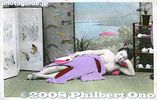
Nude woman lying down
|
|

Japanese Beauty. I would call this a representative example of a "Nihon Bijin" or Japanese Beauty photograph. She's posed formally, dressed in a kimono, and looking serene and attractive. She might bJe a geisha. Hand-colored, and undivided bI bought it for 1,200 yen.
|
|

Beauty with fan. The white space around her was for writing the correspondence. You could not write the message on the same side as the address. The back of the postcard was for the address only.So it has an undivided back, which means there is no dividing line between the address side and correspondence side, Postcards with an undivided back were made between 1900 and March 28, 1907. That's how we know the approximate age of this card even though it has no postmark.
|
|

Woman with pen and scroll. Judging from her hairstyle, this photo was probably taken during the Taisho Period (1912-1926).
|
|

Poor posture and how not to pose in a kimono.
|
|

Woman on bicycle. That's a thick shawl she's wearing. Must've been winter. It's unusual to see a bicycle used as a studio prop. Riding a bicycle while wearing a kimono must have been difficult. The postmark looks like 1908. Hand-colored.
|
|

In front of mirror. Hand-colored postcard sent as a Christmas card in 1914.
|
|

Calligraphy on a folding fan.
|
|

Dancing woman
|
|

Bride leaving her house vis rickshaw.
|
|

Bride arrives at the groom's house.
|
|
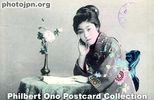
Flower in Vase. Nicely composed photograph. With a serene-looking face, she's an ideal postcard model. She also appears in the next postcard.
|
|

Girl at fence. Her posture is crooked, but somehow this photo looks nice. She's not sensationally attractive, but she's photogenic and comes across well. She also appears in the preceding postcard.
|
|

Woman with two flowers. She's holding the flowers in a cross or "X" mark. I wouldn't call that a good way to hold flowers (unless you're a hula dancer).
|
|

Woman and flower patch. Same woman as in the preceding postcard.
|
|

Girl with Bouquet. Would've been a great shot if she had smiled.
|
|

Woman with flowers. She's wearing two rings on her left hand. She looks like a wife alright. How can you tell? Well, her kimono has a plain design, and the word "married" is written on her face.
|
|

Woman and cherry blossoms. Unfortunately, she's too hunchbacked in this picture.
|
|

Teruha with chrysanthemum. The flower she's holding matches her kimono design that shows the same flower. Her name was Teruha and she appeared in many postcards. She was born in 1896 in Osaka and worked as a geisha in Shimbashi, Tokyo. Click to read mTeruha with chrysanthemum. The flower she's holding matches her kimono design that shows the same flower. Her name was Teruha and she appeared in many postcards. She was born in 1896 in Osaka and worked as a geisha in Shimbashi, Tokyo before becoming a Buddhist priest in Kyoto. Read more about her interesting life by James A. Gatlin at geikogallery.com.
|
|

Teruha sitting.Her name was Teruha and she appeared in many postcards. She's probably still in her teens in this photo. She was born in 1896 in Osaka and worked as a geisha in Shimbashi, Tokyo before becoming a Buddhist priest in Kyoto. Read more about her interesting life by James A. Gatlin at geikogallery.com.
|
|

Rear and side views. Nice side and back shot of a kimono woman. Can't see any wedding ring, but she looks married.
|
|

Tres Flores. Intriguing pose. It looks like a modern postcard, but it's postmarked 1907!
|
|

Typical woman and flower. Give a woman a flower and ask her to pose with it, and this is how she typically would hold it.
|
|

Flower arrangement. She's about to put the flower into the vase made of bamboo. On her lap, there's a pair of scissors used for flower arrangement. Her purple kimono has a design showing wisteria flowers. The season must have been spring.The card was printed in color so it's not that old.
|
|
|
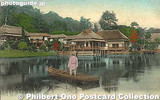
Vintage postcard of Genkyuen Garden. Little has changed except that boats no longer ply on the pond.
|
|

Hiroshima Castle in the early 1900s from a vintage postcard.
|
|

Imasu-juku was the fifty-ninth of the sixty-nine stations or shukuba post towns of the Nakasendo Road. It follows Sekigahara-juku and comes before Kashiwabara-juku in Shiga Pref. Hiroshige woodblock print of Imasu.
|
|

The tall tree on a hill indicates the site of Imasu-juku's Ichirizuka or milestone. 今須宿の一里塚
|
|

Imasu-juku's Ichirizuka or milestone. Today, Imasu is a small, sleepy cluster of houses. It has no train station, but you could walk it from Kashiwabara Station. 今須宿の一里塚
|
|

Imasu-juku's Ichirizuka or milestone on the west end of Imasu. 今須宿の一里塚
|
|

Site of Imasu-juku's Honjin lodge.
|
|

Site of Imasu-juku's Honjin lodge. 今須宿本陣跡
|
|

Site of Imasu-juku's Honjin lodge. 今須宿本陣跡
|
|

Site of Imasu-juku's Honjin lodge. 今須宿本陣跡
|
|

Entrance to Imasu Elementary and Junior High School. This was the site of the two Waki-Honjin lodges. 今須小中学校
|
|

Imasu-juku's most notable shukuba-era building called the Toiyaba. It is the only Toiyaba still existing among the 16 post towns in Mino (Gifu). 今須宿問屋場
|
|

The Toiyaba was like the town's logistics management office where they arranged lodging, horses, document deliveries, etc., for officials and travelers. Today, this building is a private residence. 今須宿問屋場
|
|

Imasu-juku's Toiyaba. 今須宿問屋場
|
|

Imasu-juku's Toiyaba. 今須宿問屋場
|
|

Path to Myooji temple. 妙応寺
|
|
|
|
|
|

Imasu Post Office
|
|

Shinshuji temple 真宗寺
|
|

Imasu-juku on the Nakasendo
|
|

Hydrangea along the river in Imasu.
|
|

Imasu-juku on the Nakasendo
|
|

Hachiman Jinja Shrine in Imasu.
|
|

Imasu-juku has many stone lanterns.
|
|

Imasu-juku's most famous stone lantern is this Eitai Joyato or Eternal Lantern which lit the road at night for travelers. 永代常夜灯
|
|

Marker indicating the west entrance of Imasu-juku.
|
|

Keage Incline postcardThe Keage Incline was in operation until 1948.
|
|
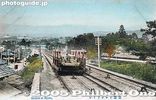
Keage Incline postcardThe Keage Incline was in operation until 1948.
|
|

Itabashi-shuku (or Itabashi-juku) was the first post town on the Nakasendo Road from Nihonbashi to Kyoto. It was where travelers lodged and arranged travel logistics. Today, Itabashi-juku is totally modern, basically a shopping and residential area.Ukiyoe print of Itabashi-juku by Eisen.
|
|

But I was able to find a few remnants of the old post town or at least stone markers. Itabashi-juku had three sections, Hirao-shuku, Naka-shuku, and Kami-shuku. Naka-shuku was in the middle and the busiest part of the town.
|
|
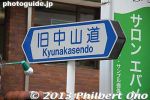
There is also Itabashi Bridge after which Itabashi Ward takes its name. You can walk along Itabashi-juku from Shin-Itabashi Station to Itabashi-Honcho Station on the Mita subway line.
|
|
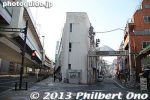
I walked from Shin-Itabashi Station to this entrance to Itabashi-shuku on the right. In the middle, they used to have the old Itabashi Police Station until 1933.
|
|
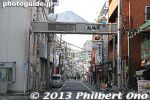
Entrance to Itabashi-shuku. Itabashi-shuku had one Honjin lodge for VIPs, three Waki-honjin, and 54 other lodges.
|
|
|
|
|

About Itabashi-shuku.
|
|
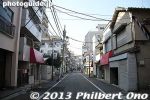
Today, Itabashi-shuku is a hodgepodge of shops, restaurants, and condominiums.
|
|
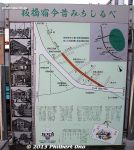
Roadside map showing places of interest. Temples are the main remnants still remaining from the old days.
|
|
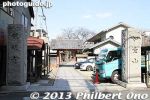
Entrance to Kanmyoji temple.
|
|
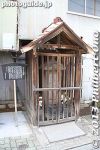
Koshin-to stone monument 庚申塔
|
|
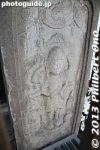
Koshin-to stone monument at Kanmyoji temple in Itabashi-shuku, Tokyo 庚申塔
|
|

About the Koshin-to stone monument 庚申塔
|
|
| 974 files on 4 page(s) |
1 |
 |
|